995 scholarly books by The Institution of Engineering and Technology and 74
start with M
995 scholarly books by The Institution of Engineering and Technology and 74
995 scholarly books by The Institution of Engineering and Technology
74 start with M start with M
74 start with M start with M
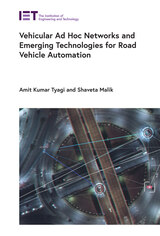
Machine Learning, Blockchain Technologies and Big Data Analytics for IoTs
Methods, technologies and applications
Amit Kumar Tyagi
The Institution of Engineering and Technology, 2022
Internet of Things (IoTs) are now being integrated at a large scale in fast-developing applications such as healthcare, transportation, education, finance, insurance and retail. The next generation of automated applications will command machines to do tasks better and more efficiently. Both industry and academic researchers are looking at transforming applications using machine learning and deep learning to build better models and by taking advantage of the decentralized nature of Blockchain. But the advent of these new technologies also brings very high expectations to industries, organisations and users. The decrease of computing costs, the improvement of data integrity in Blockchain, and the verification of transactions using Machine Learning are becoming essential goals.
[more]
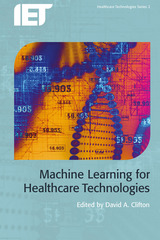
Machine Learning for Healthcare Technologies
David A. Clifton
The Institution of Engineering and Technology, 2017
This book provides a snapshot of the state of current research at the interface between machine learning and healthcare with special emphasis on machine learning projects that are (or are close to) achieving improvement in patient outcomes. The book provides overviews on a range of technologies including detecting artefactual events in vital signs monitoring data; patient physiological monitoring; tracking infectious disease; predicting antibiotic resistance from genomic data; and managing chronic disease.
[more]
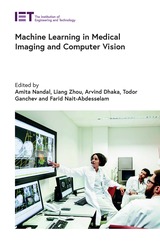
Machine Learning in Medical Imaging and Computer Vision
Amita Nandal
The Institution of Engineering and Technology, 2024
Medical images can highlight differences between healthy tissue and unhealthy tissue and these images can then be assessed by a healthcare professional to identify the stage and spread of a disease so a treatment path can be established. With machine learning techniques becoming more prevalent in healthcare, algorithms can be trained to identify healthy or unhealthy tissues and quickly differentiate between the two. Statistical models can be used to process numerous images of the same type in a fraction of the time it would take a human to assess the same quantity, saving time and money in aiding practitioners in their assessment.
[more]
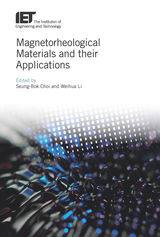
Magnetorheological Materials and their Applications
Seung-Bok Choi
The Institution of Engineering and Technology, 2019
The rheological properties of magnetorheological (MR) materials, such as their viscosity and dynamic modulus, can be tuned or controlled by changing the intensity of the magnetic field using appropriate control schemes. Thanks to their robustness, performance and smart properties, numerous studies have been undertaken on the development of new MR materials, and microscopic and macroscopic modelling approaches. Novel applications include engine mounts and clutch systems in the automotive industry, shock absorbing safety devices for cockpit seats in aerospace, and shock absorption from movement in semi-active human prosthetic legs.
[more]

Maintaining Effective Engineering Leadership
A new dependence on effective process
Raymond Morrison
The Institution of Engineering and Technology, 2013
Maintaining Effective Engineering Leadership explores process as a means of maintaining leadership development. The author argues that engineering leadership is the result of the development of four fundamental concepts: personal managerial skills, self-leadership skills, operational leadership skills, and organizational leadership skills. Each is explored in turn, and examples are taken from the space shuttle Columbia disaster to show the importance of these processes and skills, and what can happen when they are ignored. The book introduces the Capability Maturity Model which provides organizations with appropriate processes and knowledge guidelines to ensure effective leadership to avoid such disasters. Topics covered include:
[more]

Management Guide to Condition Monitoring in Manufacture
A. Davies
The Institution of Engineering and Technology, 1990
This book is simply intended to be a guide to the subject, to enable those wishing to implement Condition Monitoring to be more aware of the nature and benefits of its practice and techniques, and so help them to get started. In fact, to date everything suggests that British industry is somewhat unaware of the potential advantages that Condition Monitoring can bring to sharpen the competitive edge - and that many producers are quite uniformed even of the method and application of Condition Monitoring itself, as an aid to reliable production and for maintaining the condition of factories at peak performance. To be totally effective in a modern manufacturing application, Condition Monitoring should be considered firstly at the design stage; as 'built-in', and then as part of an on-going Condition Based Maintenance policy. It is essentially plant Predictive Maintenance by 'health checks', conducted throughout the equipment life-cycle. So as such, this guide is deliberately not exhaustive in its coverage, but highlights the main ingredients, the various aspects being simply expressed and supported by additional reading and where to get help if desired.
[more]

A Management Guide to Logistics Engineering
K. Beal
The Institution of Engineering and Technology, 1989
This guide will prove a great help to businesses in providing the pratical advice that will enable them to master the art of logistics so it can be used to their best business advantage.
[more]

Managing Complexity in Software Engineering
R.J. Mitchell
The Institution of Engineering and Technology, 1990
Software engineering products are becoming ever more complex, because software is being used in the solution of more technically difficult problems and because the size of software projects continues to grow. A key question for software engineers is how to cope with this complexity. There is no single answer, and software engineers must attack the problem from a number of perspectives. A technical perspective reveals new paradigms for system development, including two paradigms that show particular promise: object-oriented design and formal methods. A management perspective recognises that good project management is vital to the success of a complex project. The scale of modern projects makes it essential to use automated support, so software engineers must also look at how to manage complexity from an automation perspective. Automated support can come in the form of discrete tools for particular tasks, or a packaged set of tools in a support environment.
[more]

Managing Internet of Things Applications across Edge and Cloud Data Centres
Rajiv Ranjan
The Institution of Engineering and Technology, 2024
Cloud computing has been a game changer for internet-based applications such as content delivery networks, social networking and multi-tier enterprise applications. However, the requirements for low-latency data access, security, bandwidth, mobility, and cost have challenged centralized data center-based cloud computing models, which is driving the need for the novel computing paradigms of edge and fog computing. The internet of things (IoT) focuses on discovery, aggregation, management, and acting on data originating from internet-connected devices via programmable sensors, actuators, mobile phones, surveillance cameras, routers, gateways and switches. But the aggregation of this data is expensive and can be time consuming.
[more]
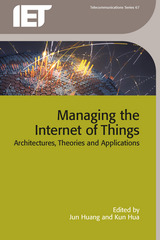
Managing the Internet of Things
Architectures, theories and applications
Jun Huang
The Institution of Engineering and Technology, 2017
The Internet of Things (IoT) refers to the evolution of the internet as the interconnection not just of computers, but also uniquely identifiable, pervasive embedded devices. Research has estimated there will be nearly 30 billion devices on the Internet of Things within the next decade. The implementation and deployment of the IoT brings with it management challenges around seamless integration, heterogeneity, scalability, mobility, security, and many other issues. This book explores these challenges and possible solutions.
[more]
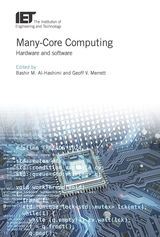
Many-Core Computing
Hardware and software
Bashir M. Al-Hashimi
The Institution of Engineering and Technology, 2019
Computing has moved away from a focus on performance-centric serial computation, instead towards energy-efficient parallel computation. This provides continued performance increases without increasing clock frequencies, and overcomes the thermal and power limitations of the dark-silicon era. As the number of parallel cores increases, we transition into the many-core computing era. There is considerable interest in developing methods, tools, architectures and applications to support many-core computing.
[more]
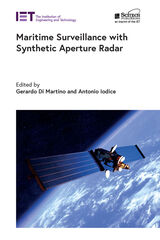
Maritime Surveillance with Synthetic Aperture Radar
Gerardo Di Martino
The Institution of Engineering and Technology, 2021
This book covers the use of SAR for maritime surveillance applications. It provides a comprehensive source of material on the subject, divided into two parts. The first part deals with models and techniques, while the second part is devoted to maritime surveillance applications. Each chapter covers the basic principles, a critical review of the current technology, techniques and applications, and the latest developments in the field.
[more]

Mathematical Quantum Physics for Engineers and Technologists
Fundamentals
Alireza Baghai-Wadji
The Institution of Engineering and Technology, 2023
Continuing size reduction in mesoscopic and nanoscopic electronic, photonic, and plasmonic devices makes the employment of quantum physics (QP) and quantum electrodynamics (QED) inevitable. Engineers at the forefront of these fields increasingly need to have a working knowledge of QP and, more importantly, feel confident to manoeuver through the intricate calculations involved. However, electrical engineers and applied physicists are typically unfamiliar with the sophisticated mathematical apparatus in QP and QED, which is generally perceived to be formidably abstract.
[more]
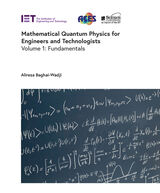
Mathematical Quantum Physics for Engineers and Technologists
Fundamentals, Volume 1
Alireza Baghai-Wadji
The Institution of Engineering and Technology, 2023
Continuing size reduction in mesoscopic and nanoscopic electronic, photonic, and plasmonic devices makes the employment of quantum physics (QP) and quantum electrodynamics (QED) inevitable. Engineers at the forefront of these fields increasingly need to have a working knowledge of QP and, more importantly, feel confident to manoeuver through the intricate calculations involved. However, electrical engineers and applied physicists are typically unfamiliar with the sophisticated mathematical apparatus in QP and QED, which is generally perceived to be formidably abstract.
[more]

Mathematical Quantum Physics for Engineers and Technologists
Governing equations, Volume 2
Alireza Baghai-Wadji
The Institution of Engineering and Technology, 2024
Continuing size reduction in mesoscopic and nanoscopic electronic, photonic, and plasmonic devices makes the employment of quantum physics (QP) and quantum electrodynamics (QED) inevitable. Engineers at the forefront of these fields increasingly need to have a working knowledge of QP and, more importantly, feel confident to manoeuver through the intricate calculations involved. However, electrical engineers and applied physicists are typically unfamiliar with the sophisticated mathematical apparatus in QP and QED, which is generally perceived to be formidably abstract.
[more]
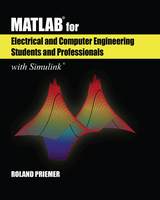
MATLAB® for Electrical and Computer Engineering Students and Professionals
With Simulink®
Roland Priemer
The Institution of Engineering and Technology, 2013
This book combines the teaching of the MATLAB® programming language with the presentation and development of carefully selected electrical and computer engineering (ECE) fundamentals. This is what distinguishes it from other books concerned with MATLAB®: it is directed specifically to ECE concerns. Students will see, quite explicitly, how and why MATLAB® is well suited to solve practical ECE problems.
[more]
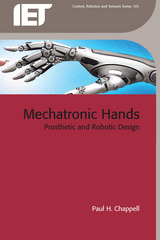
Mechatronic Hands
Prosthetic and robotic design
Paul H. Chappell
The Institution of Engineering and Technology, 2016
This book describes the technical design characteristics of the main components that go into forming an artificial hand, whether it is a simple design that does not have a natural appearance, or a more complicated design where there are multiple movements of the fingers and thumb. Mechanical components obviously form the structure of any hand, while there are some lesser known ideas that need to be explored such as how to process a slip signal.
[more]

Medical Equipment Engineering
Design, manufacture and applications
Wai Yie Leong
The Institution of Engineering and Technology, 2023
The evolution of medical equipment engineering is progressing rapidly, with advances in digital healthcare technologies such as artificial intelligence, virtual/augmented reality, 3D-printing, robotics and nanotechnologies developing at pace. Medical equipment engineering can assist in surveying workplace inefficiencies, and develop efficient optimisation processes, through data research and intelligent learning automation. This edited book covers the benefits of the integration of lean manufacturing, smart sensors, 5G technology, IoTs, virtual reality, 3D printing, robotics and automation.
[more]
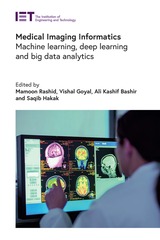
Medical Imaging Informatics
Machine learning, deep learning and big data analytics
Mamoon Rashid
The Institution of Engineering and Technology, 2024
Medical imaging informatics play an important role in the effectiveness of present-day healthcare systems. Advancement of artificial intelligence, big data analytics, and internet of things technologies contribute greatly to various healthcare applications. Artificial intelligence techniques are contributing to improvements with traditionally human-based systems and ensuring that the accuracy of prediction and diagnosis is being continually enhanced. The development of reliable and accurate healthcare models is becoming ever more possible with the help of machine learning and deep learning technologies. Artificial intelligence has the power to solve many complex problems in medical imaging and is a technology that will help to design the future of many healthcare systems.
[more]
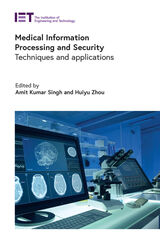
Medical Information Processing and Security
Techniques and applications
Amit Kumar Singh
The Institution of Engineering and Technology, 2022
Smart healthcare systems, made up of advanced wearable devices, internet of things (IoT) technologies and mobile internet connectivity, allow significant medical information to be easily and regularly transmitted over public networks. Personal patient information and clinical records are stored on hospitals and healthcare centres and can be accessed remotely by healthcare workers. Due to the widespread increase in the sheer volume of medical data being collected and created all the time, it has never been more important to ensure that such information is collected, stored and processed in a reliable and secure manner.
[more]
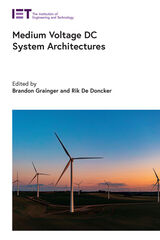
Medium Voltage DC System Architectures
Brandon Grainger
The Institution of Engineering and Technology, 2022
Direct Current (DC) transmission and distribution technologies have evolved in recent years. They offer superior efficiency, current carrying capacity, and response times as compared to conventional AC systems. Further, substantial advantages are their natural interface with many types of renewable energy resources, such as photovoltaic systems and battery energy storage systems at relatively high voltage, and compliance with consumer electronics at lower voltages, say, within a household environment. One of the core building blocks of DC-based technologies, especially at medium voltage levels, is power electronic systems technology. This cannot be emphasized enough as these units process, convert, and regulate all DC power and provide intelligence and sensing as electric power grids evolve.
[more]
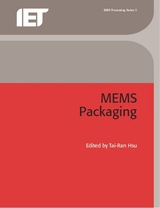
MEMS Packaging
Tai-Ran Hsu
The Institution of Engineering and Technology, 2004
Written as a collective work by 14 outstanding microsystems packaging specialists from US industries, government laboratories and universities, MEMS Packaging provides a comprehensive view of the prevalent practices and enabling techniques in the assembly, packaging and testing of MEMS and microsystems. The book also addresses aspects of microassembly and testing technologies that are often overlooked.
[more]
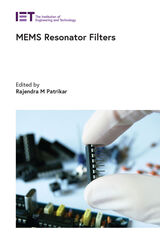
MEMS Resonator Filters
Rajendra M. Patrikar
The Institution of Engineering and Technology, 2020
The use of MEMS resonators for signal processing is relatively new and has the potential to change the topology of newer generation circuits. New materials, design and fabrication processes, and integration with conventional circuitry will need to be considered.
[more]
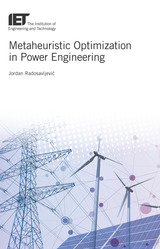
Metaheuristic Optimization in Power Engineering
Jordan Radosavljević
The Institution of Engineering and Technology, 2018
A metaheuristic is a consistent set of ideas, concepts, and operators to design a heuristic optimization algorithm, that can provide a sufficiently good solution to an optimization problem with incomplete or imperfect information. Modern and emerging power systems, with the growing complexity of distributed and intermittent generation, are an important application for such methods.
[more]
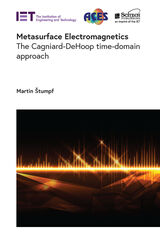
Metasurface Electromagnetics
The Cagniard-DeHoop time-domain approach
Martin Štumpf
The Institution of Engineering and Technology, 2022
The book is entirely dedicated to the exploration of time-domain electromagnetic fields in the presence of thin, high contrast sheets, with an emphasis on metasurfaces combining magnetic and dielectric properties.
[more]

Methane and Hydrogen for Energy Storage
Rupp Carriveau
The Institution of Engineering and Technology, 2016
Commercial energy storage has moved from the margins to the mainstream as it fosters flexibility in our smarter, increasingly integrated energy systems. Natural gas has been identified by many as the fuel to take us to the no-carbon horizon; where a hydrogen economy waits on development. These two actors are already connected in precursor applications as transitional solutions for hydrogen handling and transportation are sought ahead of a fully established hydrogen infrastructure.
[more]
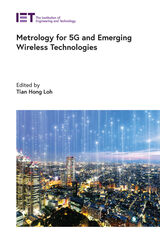
Metrology for 5G and Emerging Wireless Technologies
Tian Hong Loh
The Institution of Engineering and Technology, 2022
Metrology has a pivotal role to ensure the vision of fifth generation (5G) and emerging wireless technologies to be realised. It is essential to develop the underpinning metrology in response to the high demand for universal, dynamic, and data-rich wireless applications. As new technologies for 5G and beyond increasingly emerge in the arena of modern wireless devices/systems, the standards bodies, industries, and research communities are facing the challenge of diverse technological requirements, and on verifying products that meet desired performance parameters.
[more]

Michael Faraday's 'Chemical Notes, Hints, Suggestions and Objects of Pursuit' of 1822
Ryan D. Tweney
The Institution of Engineering and Technology, 1991
Modern life now depends on the application of Faraday's discoveries of the electric motor, transformer and the dynamo; modern physical theories reflect the field-conception of natural powers that he pioneered. Faraday's chemical notebook of 1822 is one of the most significant of Faraday's unpublished writings because it served as a place to explore possibilities and questions, rather than to record laboratory work. Transcribed and published here for the first time, the notebook shows that Faraday's physical achievements emerged from the context of applied, laboratory chemistry. It foreshadows many of his most important discoveries, and offers a revealing glimpse into the mind and scientific aspirations of a master experimentalist.
[more]
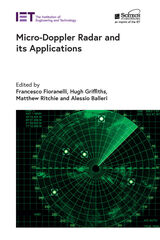
Micro-Doppler Radar and its Applications
Francesco Fioranelli
The Institution of Engineering and Technology, 2020
This book covers the latest developments in radar micro-Doppler signatures and non-cooperative recognition of moving targets, for researchers and advanced students of radar systems. Micro-Doppler signatures is a very broad topic with applications in healthcare, security and surveillance. Edited by leading researchers in the field, the book consists of a series of chapters with contributions from different groups of authors who are international experts on their topics.
[more]
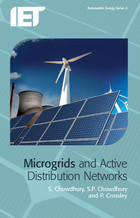
Microgrids and Active Distribution Networks
S. Chowdhury
The Institution of Engineering and Technology, 2009
A companion to Embedded Generation (IET, 2000), this book is a timely publication for an evolving industry. Renewable energy, ancillary services and deregulation of the power industry are changing electricity delivery networks. Microgrids, smartgrids and active distribution networks require a sound understanding of the basic concepts, generation technologies, impacts, operation, control and management, economic viability and market participation involved in grid integration. Practicing engineers in utilities and industry, researchers and students will appreciate this lucid description of the technologies that will enable future electricity systems.
[more]
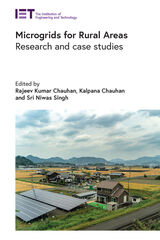
Microgrids for Rural Areas
Research and case studies
Rajeev Kumar Chauhan
The Institution of Engineering and Technology, 2020
Large rural areas in some regions of the world are still grappling with the challenge of electrification. The optimal solution is to provide reliable energy without adding more fossil fuel plants by using distributed renewable generation.
[more]
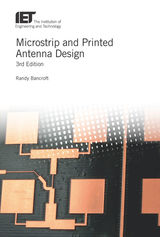
Microstrip and Printed Antenna Design
Randy Bancroft
The Institution of Engineering and Technology, 2020
This thoroughly updated third edition of this popular book covers all types of printed microstrip antenna design, from rectangular to circular, broadband and dual band, and millimeter wave microstrip antenna to microstrip arrays.
[more]
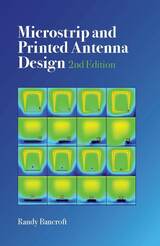
Microstrip and Printed Antenna Design
Randy Bancroft
The Institution of Engineering and Technology, 2009
The approach in this book is historical and practical. It covers basic designs in more detail than other microstrip antenna books that tend to skip important electrical properties and implementation aspects of these types of antennas. Examples include: quarter-wave patch, quarter by quarter patch, detailed design method for rectangular circularly polarized patch, the use of the TM11 (linear and broadside CP), TM21 (monopole CP pattern) and TM02 (monopole linear) circular patch modes in designs, dual-band antenna designs which allow for independent dual-band frequencies. Limits on broadband matching are discussed. The appendix contains useful simple matching approaches, design details (gain, matching, sidelobes) of the little-studied omnidirectional microstrip antenna (OMA), limits and properties of common single and dual band Planar Inverted F Antenna (PIFA) antenna designs. The second edition has numerous additions to the earlier text which will make the concepts presented clearer. New cavity model analysis equations of circular polarization bandwidth, axial ratio bandwidth and power fraction bandwidth have been included. The section on omnidirectional microstrip antennas is expanded with further design options and analysis. This is also true of the section on Planar Inverted F (PIFA) antennas. The discovery and description of the fictious resonance mode of a microstrip slot antenna has been added to that section. Appendix A, on microstrip antenna substrates has been expanded to provide more detail on the types of substrate and their composition. This is often neglected in other texts. An appendix on elementary impedance matching techniques has been added as these methods have proven useful in my industrial work.
[more]

Microstrip Antenna Theory and Design
J.R. James
The Institution of Engineering and Technology, 1981
In the past few years, the concept of creating microwave antennas using microstrip has attracted increasing attention and viable practical designs are now emerging. The purpose of this monograph is to present the reader with an appreciation of the underlying physical action, up-to-date theoretical treatments, useful antenna design approaches and the overall state-of-the-art situation. The emphasis is on antenna engineering design, but to achieve this goal it has been necessary to delve into the behaviour of microstrip in a much wider sense and also include aspects of electromagnetic analysis. As a consequence, the monograph will also be of interest to microstrip circuit designers and to some extent those seeking electromagnetic problems of a challenging nature.
[more]
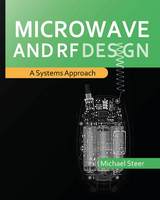
Microwave and RF Design
A Systems Approach
Michael Steer
The Institution of Engineering and Technology, 2010
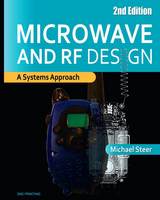
Microwave and RF Design
A Systems Approach, 2nd Edition
Michael Steer
The Institution of Engineering and Technology, 2013

Microwave Antenna Theory and Design
Samuel Silver
The Institution of Engineering and Technology, 1984
Microwave Antenna Theory and Design is an unabridged reprint of the book published by McGraw Hill, as Volume 12 of the MIT Radiation Laboratory Series in 1949. The Editor of the Volume, the late Professor Samuel Silver, contributed extensively to the text and subsequently became one of the best known people in the world of radio science.
[more]

Microwave Circuit Theory and Foundations of Microwave Metrology
Glenn F. Engen
The Institution of Engineering and Technology, 1992
No system in science or engineering can be successfully designed, analysed and specified unless it is backed up by precise quantitative measurements. This is particularly difficult in the field of microwaves where, more often than not, the parameter(s) of interest cannot be observed directly but must be inferred from the measurement of other related parameters. Although the advent of the automated network analyser has eliminated much of the previous drudgery, the problems of interpreting the digitally displayed information still remain. One purpose of this book is to provide the reader with a thorough understanding of the microwave circuit model and its limitations, and thus eliminate the many potential pitfalls that otherwise await the unwary experimenter.
[more]
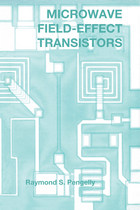
Microwave Field-Effect Transistors
Theory, design and applications
Raymond S. Pengelly
The Institution of Engineering and Technology, 1994
This book covers the use of devices in microwave circuits and includes such topics as semiconductor theory and transistor performance, CAD considerations, intermodulation, noise figure, signal handling, S-parameter mapping, narrow- and broadband techniques, packaging and thermal considerations. Perhaps the most comprehensive text on GaAs FET technology and its practical application. It covers the use of MESFET devices in microwave circuits, such as low-noise amplifiers, mixers, oscillators, power amplifiers, switches and multipliers. This text is a classic reference for all engineers involved in the development of solid state microwave devices.
[more]

Microwave Horns and Feeds
A.D. Olver
The Institution of Engineering and Technology, 1994
This book is the first comprehensive treatment of microwave horns and feeds for reflector antennas for use in satellite and terrestrial communications, radar and radio astronomy. The feed for a reflector antenna is a crucial component because the performance of the reflector depends on a good feed to collect or radiate signals.
[more]
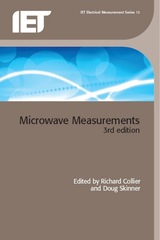
Microwave Measurements
R.J. Collier
The Institution of Engineering and Technology, 2007
The IET has organised training courses on microwave measurements since 1983, at which experts have lectured on modern developments. The purpose of this third edition of the lecture notes is to bring the latest techniques in microwave measurements to a wider audience. The book includes a survey of the theory of current microwave circuits as well as a description of the techniques for the measurement of power, spectrum, attenaution, circuit parameters, and noise, measurements of antenna characteristics, free fields, modulation and dielectric parameters. The emphasis throughout is on good measurement practice. All the essential theory is given and a previous knowledge of the subject is not assumed. The book will be of interest to those engaged in the design of microwave measurement systems in both research and industry, those providing microwave measurement systems in both research and industry, in measurement services and those involved in teaching microwave measurements in universities.
[more]
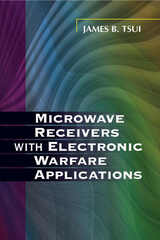
Microwave Receivers with Electronic Warfare Applications
James Bao-Yen Tsui
The Institution of Engineering and Technology, 2005
This book is a treatise on EW receivers that is relevant to you if you are just looking for a top-level insight into EW receivers or need to know the intricate details of cause and effect behavior in EW receiver theory and design. The book begins with a general discussion of EW receivers in their functional context and then goes into just the right amount of detail about the theoretical characteristics common to all receiver designs. Examples of this include receiver design issues impacting probability of detection, false alarm rate, and dynamic range performance. Tsui then describes the important characteristics of key emitter parameters to be measured by an EW receiver. He goes on to systematically cover each of the types of EW receivers by dedicating a chapter to each in well-organized and exquisite detail.
[more]
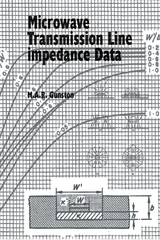
Microwave Transmission Line Impedence Data
M.A.R. Gunston
The Institution of Engineering and Technology, 1997
A compendium of data for computing the characteristic impedance of transmission lines based on physical dimensions. This book covers both conventional structures and unusual geometries, including coaxial, eccentric and elliptic coaxial, twin-wire, wire-above-ground, microstrip and derivatives, stripline, slabline and trough line. Also details numerous configurations of coupled lines.
[more]
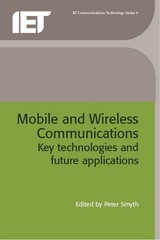
Mobile and Wireless Communications
Key technologies and future applications
Peter Smyth
The Institution of Engineering and Technology, 2004
Two of the fastest growing sectors of communications today are mobile and Internet, both of which have had a profound effect on people's lives. The convergence between these two sectors not only presents great opportunities for the future of 'unplugged' telecommunications but also great challenges in understanding the relative position of different technologies in this future.
[more]
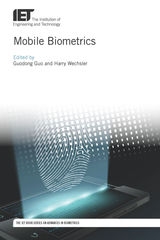
Mobile Biometrics
Guodong Guo
The Institution of Engineering and Technology, 2017
Mobile biometrics - the use of physical and/or behavioral characteristics of humans to allow their recognition by mobile/smart phones - aims to achieve conventional functionality and robustness while also supporting portability and mobility, bringing greater convenience and opportunity for its deployment in a wide range of operational environments from consumer applications to law enforcement. But achieving these aims brings new challenges such as issues with power consumption, algorithm complexity, device memory limitations, frequent changes in operational environment, security, durability, reliability, and connectivity. Mobile Biometrics provides a timely survey of the state of the art research and developments in this rapidly growing area.
[more]
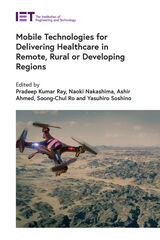
Mobile Technologies for Delivering Healthcare in Remote, Rural or Developing Regions
Pradeep Kumar Ray
The Institution of Engineering and Technology, 2020
This edited book explores the use of mobile technologies such as phones, drones, robots, apps, and wearable monitoring devices for improving access to healthcare for socially disadvantaged populations in remote, rural or developing regions. This book brings together examples of large scale, international projects from developing regions of China and Belt and Road countries from researchers in Australia, Bangladesh, Denmark, Norway, Japan, Spain, Thailand and China. The chapters discuss the challenges presented to those seeking to deploy emerging mobile technologies (e.g., smartphones, IoT, drones, robots etc.) for healthcare (mHealth) in developing countries and discuss the solutions undertaken in these case study projects.
[more]

Mobility as a Service
Its development, deployment, and future
Beate Kubitz
The Institution of Engineering and Technology, 2024
Mobility-as-a-Service (MaaS) is a much-talked about term in the transportation industry and in transport policy. The goal of MaaS is a shift away from personally-owned modes of transportation and towards mobility solutions that are consumed as a service. Such solutions are typically enabled by digital technologies and platforms. MaaS systems might combine transportation services from public and private transportation providers, like train and carsharing services, through a unified portal to create and manage journeys, which users can pay for with a single account. MaaS offers travellers mobility solutions based on their travel needs.
[more]
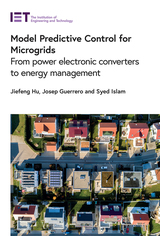
Model Predictive Control for Microgrids
From power electronic converters to energy management
Jiefeng Hu
The Institution of Engineering and Technology, 2021
Microgrids have emerged as a promising solution for accommodating the integration of renewable energy resources. But the intermittency of renewable generation is posing challenges such as voltage/frequency fluctuations, and grid stability issues in grid-connected modes. Model predictive control (MPC) is a method for controlling a process while satisfying a set of constraints. It has been in use for chemical plants and in oil refineries since the 1980s, but in recent years has been deployed for power systems and electronics as well.
[more]
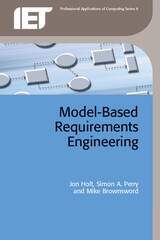
Model-Based Requirements Engineering
Jon Holt
The Institution of Engineering and Technology, 2011
This book provides a hands-on introduction to model-based requirements engineering and management by describing a set of views that form the basis for the approach. These views take into account each individual requirement in terms of its description, but then also provide each requirement with meaning by putting it into the correct 'context'. A requirement that has been put into a context is known as a 'use case' and may be based upon either stakeholders or levels of hierarchy in a system. Each use case must then be analysed and validated by defining a combination of scenarios and formal mathematical and logic-based proofs that provide the rigour required for safety-critical and mission-critical systems.
[more]
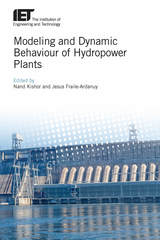
Modeling and Dynamic Behaviour of Hydropower Plants
Nand Kishor
The Institution of Engineering and Technology, 2017
Hydropower is a mature and cost-competitive renewable energy source, contributing the bulk of global renewable electricity. Over the past decades, computer technology has led to significant possible improvements in monitoring, diagnostics, protection and control through retrofitting of large plants, and there is potential for additional large plants as well as for smaller installations.
[more]
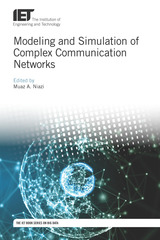
Modeling and Simulation of Complex Communication Networks
Muaz A. Niazi
The Institution of Engineering and Technology, 2019
Modern network systems such as Internet of Things, Smart Grid, VoIP traffic, Peer-to-Peer protocol, and social networks, are inherently complex. They require powerful and realistic models and tools not only for analysis and simulation but also for prediction.
[more]
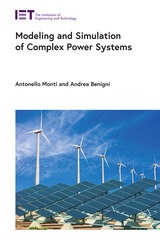
Modeling and Simulation of Complex Power Systems
Antonello Monti
The Institution of Engineering and Technology, 2022
Modern power systems are highly complex due to increasing shares of intermittent renewable energy and distributed generation. Research requires computer simulation and modeling, and knowledge of methods and algorithms.
[more]
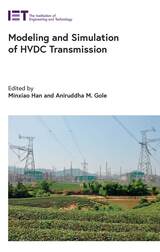
Modeling and Simulation of HVDC Transmission
Minxiao Han
The Institution of Engineering and Technology, 2021
The development of large-scale renewable generation and load electrification call for highly efficient and flexible electric power integration, transmission and interconnection. High Voltage DC (HVDC) transmission technology has been recognized as the key technology for this scenario. HVDC transmissions, including both the line commutated converter (LCC) HVDC and voltage source converter (VSC) HVDC have played an important role in the modern electric power system. However, with the inclusion of power electronic devices, HVDC introduces the characteristics of nonlinearity and different timescales into the traditional electromechanical system and thus careful modeling and simulation of HVDC transmission are essential for power system design, commissioning, operation and maintenance.
[more]
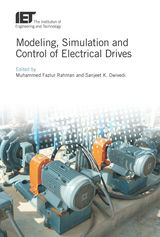
Modeling, Simulation and Control of Electrical Drives
Mohammed Fazlur Rahman
The Institution of Engineering and Technology, 2019
Thanks to advances in power electronics device design, digital signal processing technologies and energy efficient algorithms, ac motors have become the backbone of the power electronics industry. Variable frequency drives (VFD's) together with IE3 and IE4 induction motors, permanent magnet motors, and synchronous reluctance motors have emerged as a new generation of greener high-performance technologies, which offer improvements to process and speed control, product quality, energy consumption and diagnostics analytics.
[more]
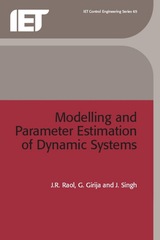
Modelling and Parameter Estimation of Dynamic Systems
J.R. Raol
The Institution of Engineering and Technology, 2004
Parameter estimation is the process of using observations from a system to develop mathematical models that adequately represent the system dynamics. The assumed model consists of a finite set of parameters, the values of which are calculated using estimation techniques. Most of the techniques that exist are based on least-square minimisation of error between the model response and actual system response. However, with the proliferation of highspeed digital computers, elegant and innovative techniques like filter error method, genetic algorithms and artificial neural networks are finding more and more use in parameter estimation problems. Modelling and Parameter Estimation of Dynamic Systems presents a detailed examination of many estimation techniques and modelling problems.
[more]

Modelling and Simulation of Small Scale Hydro Generation Systems
René Wamkeue
The Institution of Engineering and Technology, 2020
This book provides engineers, researchers and advanced students with the mathematical modelling, control and simulation tools needed for the successful design, long-term management and maintenance of a small scale hydro-power plant (HPP). It also covers the hybrid operation with other small scale renewable power plants as well as the use of a storage system. The book features case studies and test-based design, and all system components are modelled using the well-known state space form technique.
[more]

Modelling and Stability of Smart Grids
Marta Molinas
The Institution of Engineering and Technology, 2016
This comprehensive book describes how to systematically assess the stability of electrical grids with a high share of power electronics converters and considers what their presence in the electrical grid entails. It is divided into three areas: Part 1 presents the three fundamental stability analysis methods and tools for power electronics systems; Part 2 examines applications in power utility systems; and Part 3 describes applications in microgrids and mobile power systems.
[more]
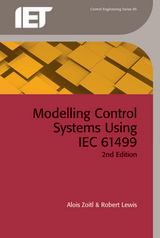
Modelling Control Systems Using IEC 61499
Alois Zoitl
The Institution of Engineering and Technology, 2014
IEC 61499 is a standard for modelling distributed control systems for use in industrial automation, and is already having an impact on the design and implementation of industrial control systems that involve the integration of programmable logic controllers, intelligent devices and sensors.
[more]
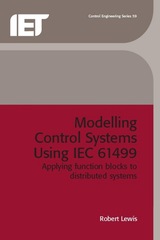
Modelling Control Systems Using IEC 61499
Applying function blocks to distributed systems
Robert Lewis
The Institution of Engineering and Technology, 2001
New technologies and standards are emerging which will have a dramatic effect on the design and implementation of future industrial control systems. PLCs and PC-based soft controllers are beginning to use software components, for example function blocks, to business systems. New tools and techniques are needed to design and model these systems, such as UML and modern fieldbus technology. The IEC 61499 standard has been developed specifically to model distributed control systems. Practical tools based on IEC 61499 are likely to emerge soon to model, validate and simulate the behaviour of complex networks of function blocks and it is expected that this standard will become key to highly-developed distributed systems.
[more]
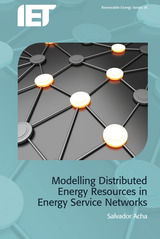
Modelling Distributed Energy Resources in Energy Service Networks
Salvador Acha
The Institution of Engineering and Technology, 2013
The smart-grid concept can mean many things, however there is a consensus that its objective involves seamlessly adopting new technologies to existing infrastructures and maximising the use of resources. Modelling Distributed Energy Resources in Energy Service Networks focuses on modelling two key infrastructures in urban energy systems with embedded technologies. These infrastructures are natural gas and electricity networks and the embedded technologies include cogeneration and electric vehicle devices. The subject is addressed using a holistic modelling framework which serves as a means to an end; this end being to optimise in a coordinated manner the operation of natural gas and electrical infrastructures under the presence of distributed energy resources, thus paving the way in which smart-grids should be managed. The modelling approach developed and presented in this book, under the name 'time coordinated optimal power flow' (TCOPF), functions as a decision maker entity that aggregates and coordinates the available DERs according to multiple criteria such as energy prices and utility conditions. The examples prove the TCOPF acts effectively as an unbiased intermediary entity that manages cost-effective interactions between the connected technologies and the distribution network operators, therefore showcasing an integral approach on how to manage new technologies for the benefit of all stakeholders.
[more]
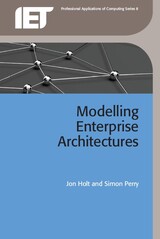
Modelling Enterprise Architectures
Jon Holt
The Institution of Engineering and Technology, 2010
For any organisation to be successful in an increasingly competitive and global working environment, it is essential that there is a clear understanding of all aspects of the business. Given that no two organisations are exactly alike, there is no definitive understanding of exactly what these aspects are as they will depend on the organisation's nature, size and so on. Some of the aspects of the business that must be considered include: process models, process descriptions, competencies, standards, methodologies, infrastructure, people and business goals.
[more]
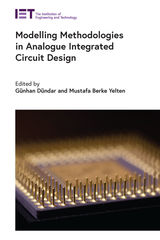
Modelling Methodologies in Analogue Integrated Circuit Design
Günhan Dündar
The Institution of Engineering and Technology, 2020
Modelling Methodologies in Analogue Integrated Circuit Design provides a holistic view of modelling for analogue, high frequency, mixed signal, and heterogeneous systems for designers working towards improving efficiency, reducing design times, and addressing the challenges of representing aging, variability, and other technical challenges at the nanometre scale.
[more]
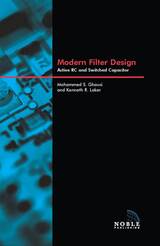
Modern Filter Design
Active RC and switched capacitor
Mohammed S. Ghausi
The Institution of Engineering and Technology, 2003
A comprehensive tutorial on active filter design analysis and design procedures. This book covers: Basic systems classifications together with filter transmission and approximations; Operational amplifiers, including bipolar and MOS integrators; Definitions of sensitivity and statistical sensitivity measures; Continuous-time second-order active sections; Higher-order filter design; Switched capacitor filters.
[more]

Modern Personal Radio Systems
R.C.V. Macario
The Institution of Engineering and Technology, 1996
This topical book builds upon an earlier IEE text Personal & mobile radio systems, by the same editor, which set out the fundamental issues in a discipline that appeared to have global expansion potential. That potential has now become a reality, and something more than a new edition of the previous book was needed to bring it up to date. This book is completely new, drawing on the experience and the many intensive studies that have been concentrated in this field in the past five years.
[more]
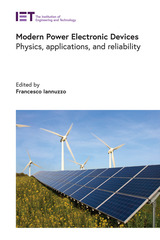
Modern Power Electronic Devices
Physics, applications, and reliability
Francesco Iannuzzo
The Institution of Engineering and Technology, 2020
Power devices are key to modern power systems, performing essential functions such as inverting and changing voltages, buffering, and switching. The increasing complexity of power systems, with distributed renewable generation on the rise, is posing challenges to these devices. In recent years, several new devices have emerged, including wide bandgap devices, each with advantages and weaknesses depending on circumstances and applications.
[more]
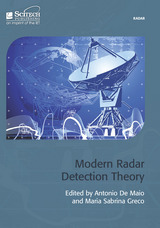
Modern Radar Detection Theory
Antonio De Maio
The Institution of Engineering and Technology, 2016
Recently, various algorithms for radar signal detection that rely heavily upon complicated processing and/or antenna architectures have been the subject of much interest. These techniques owe their genesis to several factors. One is revolutionary technological advances in high-speed signal processing hardware and digital array radar technology. Another is the stress on requirements often imposed by defence applications in areas such as airborne early warning and homeland security.
[more]
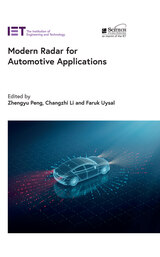
Modern Radar for Automotive Applications
Zhengyu Peng
The Institution of Engineering and Technology, 2022
Radar is a key technology in the safety system of a modern vehicle. Automotive radars are the critical sensors in advanced driver-assistance systems, which are used in adaptive cruise control, collision avoidance, blind spot detection, lane change assistance, and parking assistance.
[more]
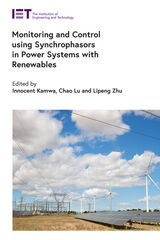
Monitoring and Control using Synchrophasors in Power Systems with Renewables
Innocent Kamwa
The Institution of Engineering and Technology, 2020
With the integration of more distributed or aggregated renewables, and the wide utilization of power electronic devices, modern power systems are facing new stability and security challenges, such as the weakly damped oscillation caused by wind farms connected through long distance transmission lines, the frequency stability problem induced by the reduction of inertia and the voltage stability issue resulting from the interactions between transmission systems and dynamic loads.
[more]
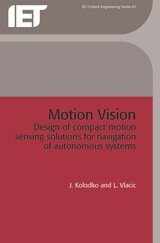
Motion Vision
Design of compact motion sensing solutions for navigation of autonomous systems
J. Kolodko
The Institution of Engineering and Technology, 2005
Segmenting the environment surrounding an autonomous vehicle into coherently moving regions is a vital first step towards intelligent autonomous navigation. Without this temporal information, navigation becomes a simple obstacle avoidance scheme that is inappropriate in highly dynamic environments such as roadways and places where many people congregate.
[more]
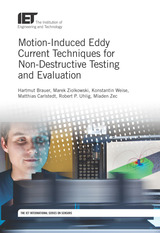
Motion-Induced Eddy Current Techniques for Non-Destructive Testing and Evaluation
Hartmut Brauer
The Institution of Engineering and Technology, 2019
Non-destructive testing (NDT) analysis techniques are used in science, technology and medicine to evaluate the properties of a material, component or system, without causing damage or altering the article being inspected. It is a highly valuable technique that can save money and time in product evaluation, troubleshooting, and research. Well known and widely used in industrial applications since the 60s, the NDT market is developing and growing fast. This book focuses on electromagnetic NDT methods and more specifically on the motion induced eddy current testing and evaluation (MIECTE) techniques used for conductive materials via electromagnetic methods, focusing on the Lorentz force eddy current testing (LET) method which was introduced recently. The authors present the modelling and simulation of LET systems as well as the optimal design of the measurement setups. They also show the wide variety of applications of the LET method including defect identification and sigmometry to estimate electrical conductivity of the tested material.
[more]
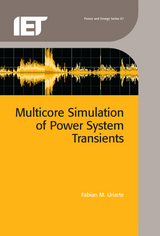
Multicore Simulation of Power System Transients
Fabian M. Uriarte
The Institution of Engineering and Technology, 2013
Multicore technology has brought about the reexamination of traditional power system electromagnetic transient simulation methods. The technological penetration of this advancement in power system simulation is not noticeable, but its demand is growing in importance in anticipation of the many-core shift. The availability of this technology in personal computers has orchestrated the redesign of simulation approaches throughout the software industry - and in particular, the parallelization of power system simulation.
[more]

Multidimensional Magnetic-Field Microsensors
Chavdar Roumenin
The Institution of Engineering and Technology, 2017
Magnetic field sensors have made significant advances over the past decade, and have found commercial importance in ubiquitous systems with navigation needs such as mobile phones - every mobile phone now contains a vectorial magnetic field sensor. This book provides a comprehensive introduction to the underlying theory of magnetic-field microsensors, their construction, and current and future applications. Written by leading experts in the development of these sensors, this book is essential reading for academics and advanced students working in sensor design and application.
[more]
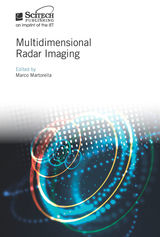
Multidimensional Radar Imaging
Marco Martorella
The Institution of Engineering and Technology, 2020
Synthetic aperture radar and inverse synthetic aperture radar (SAR/ISAR) images have been largely used for monitoring small to large areas and more specifically for target recognition/identification. However, the technology has limitations due to the use of classical monostatic, single channel, single frequency and single polarization systems. To overcome these limitations, solutions have been proposed that show the benefit of using multiple frequencies, spatial channels, polarisations and perspective, in one word multi-dimensional radar imaging systems when dealing with non-cooperative targets.
[more]
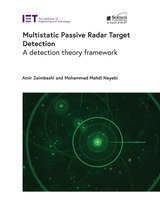
Multistatic Passive Radar Target Detection
A detection theory framework
Amir Zaimbashi
The Institution of Engineering and Technology, 2023
This book is devoted to target detection in a class of radar systems referred to as passive multistatic radar. This system is of great interest in both civilian and military scenarios due to many advantages. First, this system is substantially smaller and less expensive compared to an active radar system. Second, the multistatic configuration improves its detection and classification capabilities. Finally, there are many signals available for passive sensing making them hard to avoid.
[more]
READERS
Browse our collection.
PUBLISHERS
See BiblioVault's publisher services.
STUDENT SERVICES
Files for college accessibility offices.
UChicago Accessibility Resources
home | accessibility | search | about | contact us
BiblioVault ® 2001 - 2024
The University of Chicago Press









